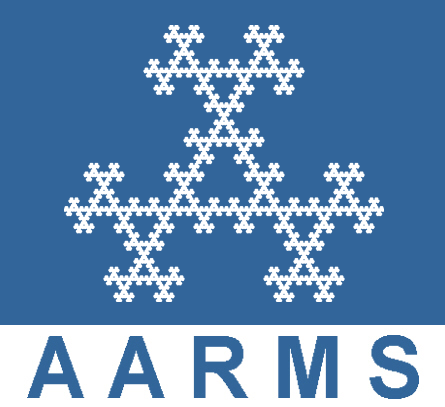2015 CMS Summer Meeting
University of Prince Edward Island, June 5 - 8, 2015
Singularities and Phase Transitions in the Calculus of Variations and PDE
Org: Lia Bronsard and Ihsan Topaloglu (McMaster)
[PDF]
Org: Lia Bronsard and Ihsan Topaloglu (McMaster)
[PDF]
- STANLEY ALAMA, McMaster University
Minimizers of the Landau-de Gennes energy around a spherical colloid particle [PDF]
-
We consider energy minimizing configurations of a nematic liquid crystal around a spherical colloid particle, in the context of the Landau-de~Gennes model. The nematic is assumed to occupy the exterior of a ball $B_{r_0}$, and satisfy homeotropic weak anchoring at the surface of the colloid and approach a uniform uniaxial state as $|x|\to\infty$. We study the minimizers in two different limiting regimes: for balls which are small $r_0\ll L^{\frac12}$ compared to the characteristic length scale $L^{\frac 12}$, and for large balls, $r_0\gg L^{\frac12}$. The relationship between the radius and the anchoring strength $W$ is also relevant. For small balls we obtain a limiting quadrupolar configuration, with a ``Saturn ring'' defect for relatively strong anchoring, corresponding to an exchange of eigenvalues of the $Q$-tensor. In the limit of very large balls we obtain an axisymmetric minimizer of the Oseen--Frank energy, and a dipole configuration with exactly one point defect is obtained. This represents joint work with L. Bronsard and X. Lamy.
- RUSTUM CHOKSI, McGill University
Nonlocal Energy Functionals Consisting of Competing Attractive and Repulsive Potentials [PDF]
-
We consider existence and properties of minimizers for a class of nonlocal functionals consisting of power-law attractive and repulsive potentials.
We will address different cases where these functionals are defined over measures, functions, and binary functions (set interactions).
Comparison will be made with minimizers of a high-order isoperimetric problem with nonlocal interactions of Coulombic type.
This is joint work with I. Topaloglu (McMaster University) and, in part, R. Fetecau (Simon Fraser University).
- MICHAEL GELANTALIS, RWTH Aachen University
Cahn-Hilliard energy barrier and $\Gamma$-convergence in a certain parameter regime [PDF]
-
We study the d-dimensional Cahn-Hilliard energy on the flat torus in a
parameter regime in which the system size is large and the mean value is
close---but not too close---to -1. We derive a leading order estimate
of the size of the energy barrier that surrounds the uniform state, in
the case where the latter is a
local but not global energy minimizer. A sharp interface version of the
ideas involved leads to a $\Gamma$-limit of the rescaled energy gap
between a given function and the uniform state, which can be used to
derive information on the existence and shape of nonconstant "droplet"
local minimizers of the energy. This is the result of joint work with Maria Westdickenberg.
- TIZIANA GIORGI, New Mexico State University
Sawtooth profile in smectic A liquid crystals [PDF]
-
We study the Chen-Lubensky free energy functional to understand the zigzag pattern formed in a smectic A liquid crystal in the presence of an applied magnetic field. We identify a small dimensionless parameter $\epsilon$, and investigate the behavior of the minimizers when the field strength is of order $\mathcal{O}(\epsilon^{-1})$. In this regime, we show via $\Gamma$-convergence that a sawtooth profile is favored. We also carry out numerical simulations illustrating the zigzag structure. Our mathematical results are consistent with the experimental picture presented in the physics literature. This is joint work with C. J. Garcia-Cervera and S. Joo.
- DMITRY GOLOVATY, The University of Akron
Dimension reduction for the Landau-de Gennes model in nematic thin films. [PDF]
-
We use the method of $\Gamma$-convergence to study the behavior of the Landau-de Gennes model for a nematic liquid crystalline film in the limit of vanishing thickness. In this asymptotic regime, surface energy plays a greater role and we take particular care in understanding its influence on the structure of the minimizers of the derived two- dimensional energy. We assume general weak anchoring conditions on the top and the bottom surfaces of the film. The constants in the weak anchoring conditions are chosen so as to enforce that a surface-energy-minimizing nematic $Q$-tensor has the normal to the film as one of its eigenvectors. We establish a general convergence result and then discuss the limiting problem in several parameter regimes.
- PETER STERNBERG, Indiana University
Reduced model for the hydroelastic waves in the cochlea [PDF]
-
Hydroelastic waves in the cochlea are studied through modeling a passive basilar membrane as an elastic spring. A rigorous reduction of the three-dimensional equations for the fluid pressure and deflection of the basilar membrane to a one-dimensional ordinary differential equation for the pressure jump across the membrane is derived. The one dimensional reduced model is then critically examined and limits on its validity are discussed. An approximate solution of the reduced equations is in agreement with the experimental Greenwood formula for a proper selection of elastic parameters. The model is used to compute the effect of cochlear implants on the Place Principle governing the spectral decomposition of sound by the cochlea. Numerics are also
carried out to see the effect of a cochlear implant on the mechanical response of the cochlea.
This is joint work with Lydia Peres Hari and Jacob Rubinstein
- IHSAN TOPALOGLU, McMaster University
Generalized Gradient Flows of Nonlocal Interaction Energies [PDF]
-
In this talk, I will consider a generalized notion of gradient flow, i.e., curves of maximal slope, for nonconvex nonlocal interaction energies $E(\mu)=\iint_{\mathbb{R}^d\times\mathbb{R}^d} K(x-y)\,d\mu(x)d\mu(y)$ defined via a pairwise singular interaction potential $K$ in the power-law form over the space of probability measures with bounded density endowed with the 2-Wasserstein metric. These energies play an important role in models of collective behaviour of multi-agent systems, biological swarming, molecular self-assembly. In particular, I will show that these curves of maximal slopes can be obtained as limits as $\epsilon\to 0$ of well-understood gradient flows of semi-convex energies $E_\epsilon$ defined by a regularization of the interaction potential $K$. This will also provide a first step in understanding the connection between the gradient flows of unregularized and noncovex interaction energies $E$ and the aggregation equation $$\mu_t - \nabla\cdot(\mu(\nabla K * \mu))=0$$ via a singular perturbation approach. This is joint work with Katy Craig (UCLA).







